Spread across Venice’s Giardini, the adjoining Arsenale, and numerous collateral venues throughout town, the 19th edition of the Biennale Architettura is a comprehensive survey of the field as it stands. The historical city, with its distinct network of canals and wooden pile construction, serves as a dramatic yet appropriate backdrop to address some of the most critical issues facing our world today. It’s true that Venice is sinking and finds itself at the precipice of the climate crisis.
Highlights from the 19th Venice Architecture Biennale
Architecture’s preeminent festival returns this summer with a strong focus on sustainability, adaptability, and collaboration. These pavilion and collateral exhibits pass muster.
BY ADRIAN MADLENER May 27, 2025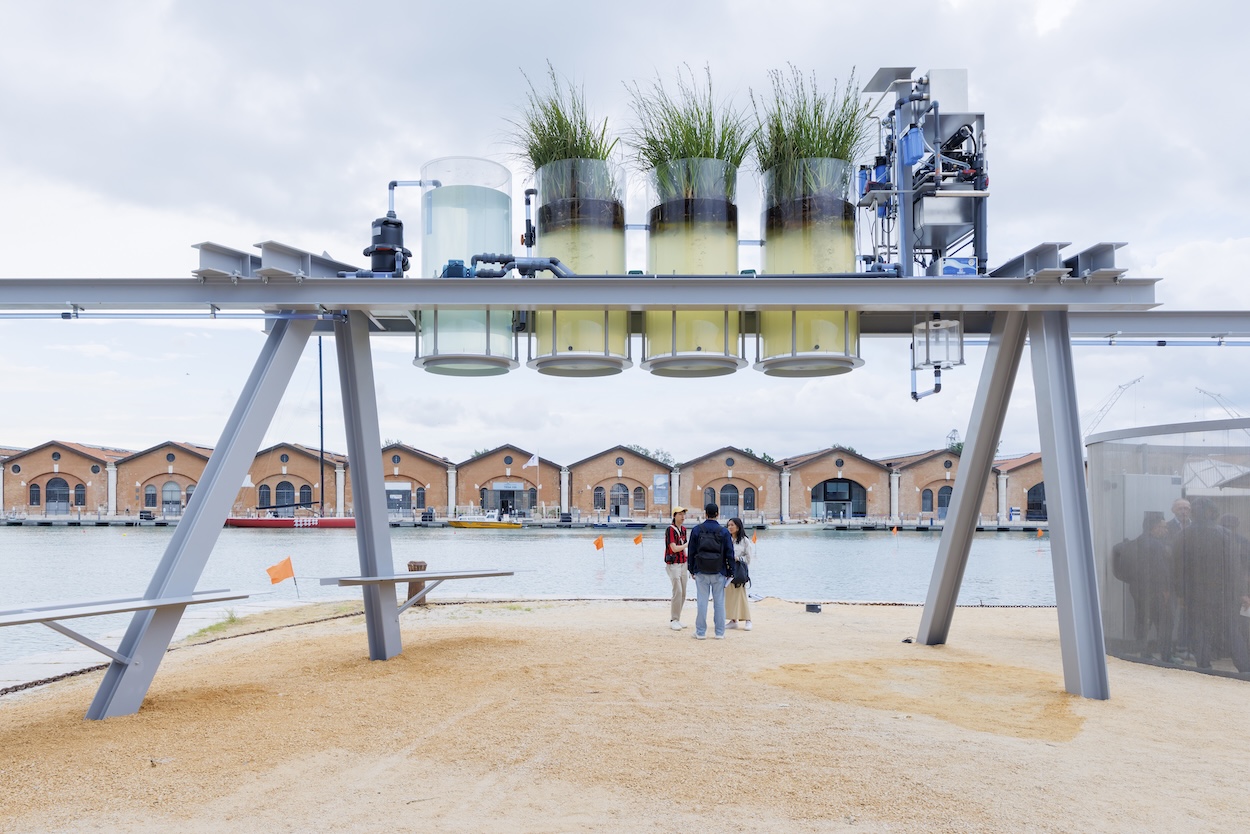
Rather than simply demonstrate how existing strategies are being used to tackle the myriad problems surrounding this existential threat, the festival—incorporating more than 60 national and independent exhibits—is presenting various speculative and applicable solutions that go beyond the conventional approaches that have only gotten us so far. Not just based on using the latest technologies, like A.I.,these future-forward proposals also reveal how architects are looking to history for fresh ideas.
“From the earliest ‘primitive hut,’ human design has been led by the need for shelter and survival, driven by optimism: our creations have always strived to bridge the gap between a harsh environment and the safe, livable spaces we require,” Carlo Ratti, the curator of this Biennale, wrote in his statement. “For decades, architecture’s response to the climate crisis has been centered on mitigation—designing to reduce our impact on the climate. But that approach is no longer enough. The time has come for architecture to embrace adaptation: rethinking how we design for an altered world.”
As revealed in the five exhibits highlighted below, sustainability is much more than ecology. It’s also about dealing with the lasting impact of colonialism and resource extraction; reconsidering ancient building typologies with new materials; reassessing what hospitality and coexistence means in different contexts; and tapping into the potential of adaptive reuse. Entitled Intelligens Natural. Artificial. Collective, the 19th Biennale Architettura runs until November 23.
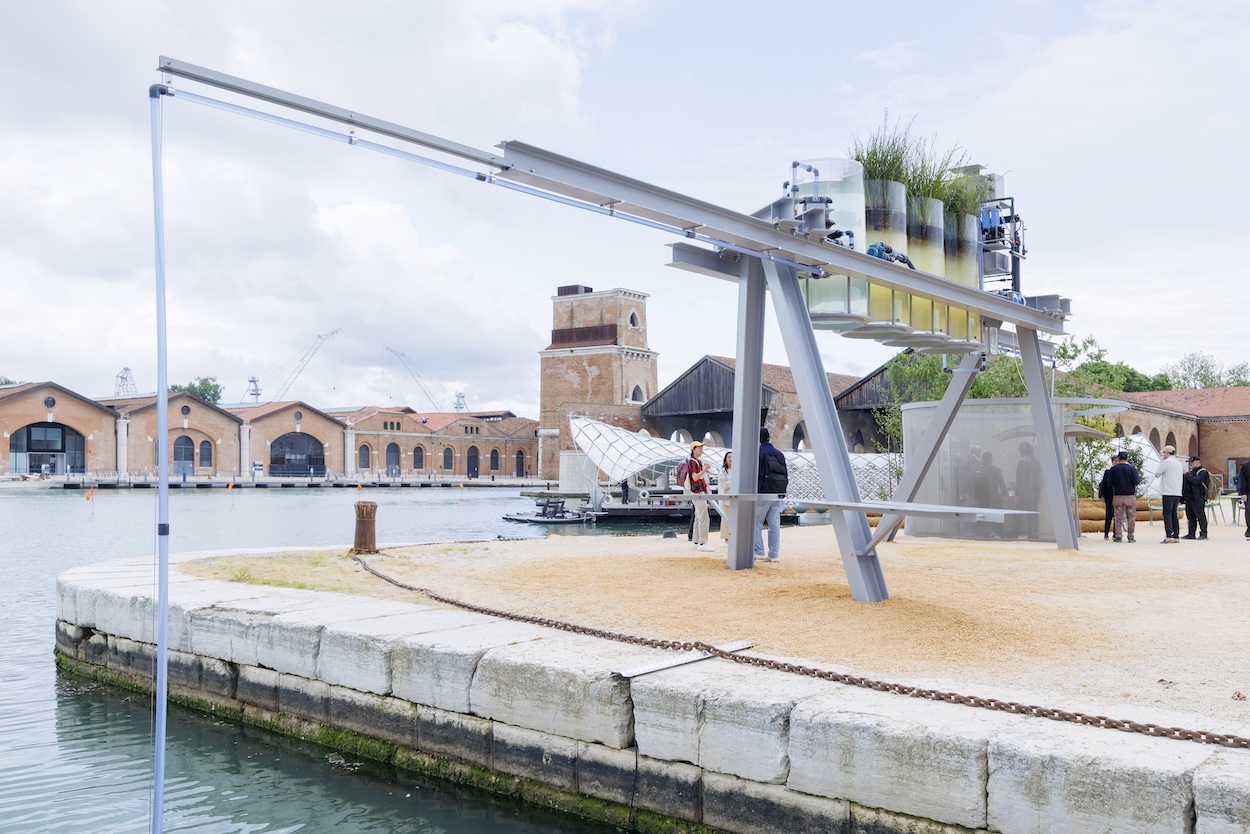
Canal Café by Diller Scofidio + Renfro
Standing tall along the embankment that lines the Arsenale is a peculiar contraption consisting of I-beams and large clear cylinders filled with murky liquid. Developed in partnership with Aaron Betsky, Natural Systems Utilities, SODAI, and chef Davide Oldani, New York-based architecture firm Diller Scofidio + Renfro conceived Canal Café as a hybrid natural-artificial purification system turning polluted lagoon water into a potable substance: espresso available throughout the run of the festival.
The “eco-machine” accelerates the filtration process by harnessing the latest technologies but also the innate sterling force of wetlands. This especially resolute and site-specific proposal received the Golden Lion, the Biennale’s top prize. No one, purportedly, has gotten sick from drinking the coffee.
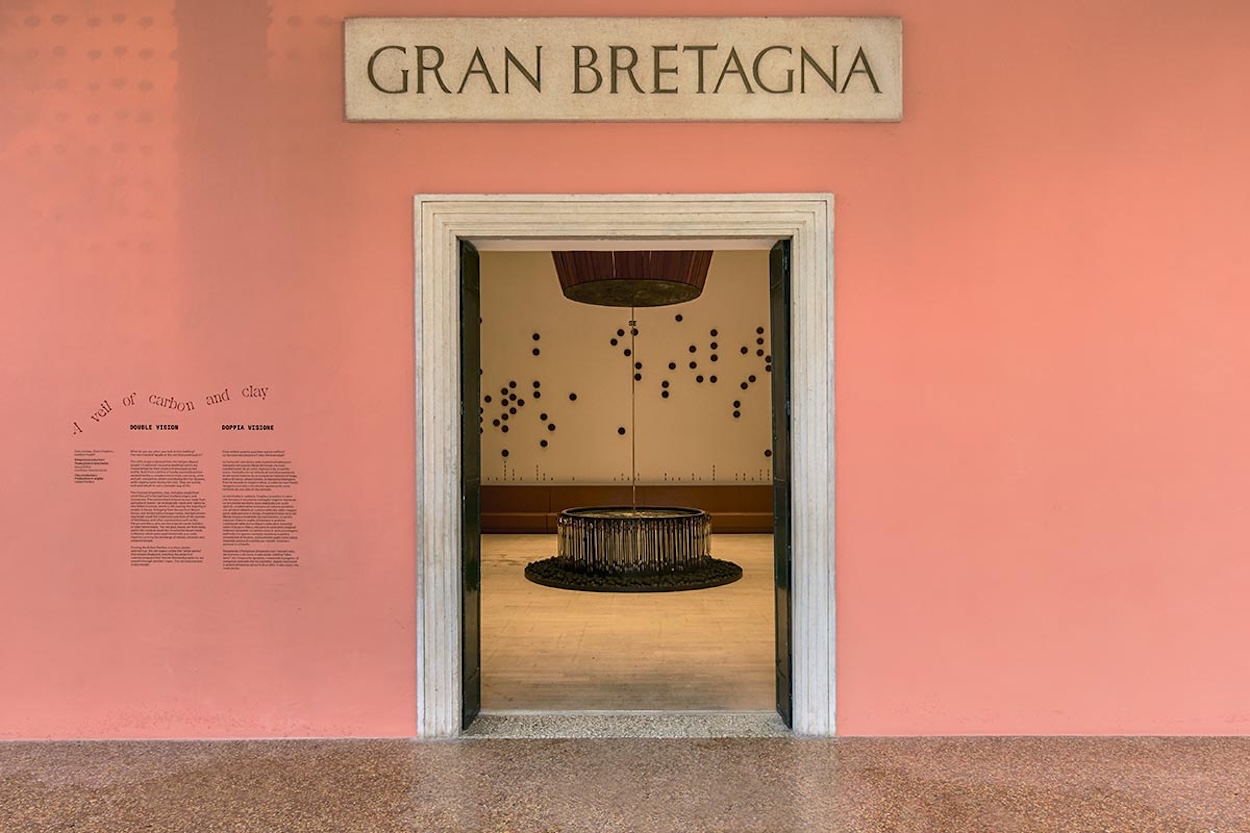
British Pavilion: Geology of Britannic Repair
Covered in a veil of clay orbs strung together by cords—an installation handmade by Kenyan artisans using traditional Maasai techniques—the normally neoclassic British Pavilion is cutting a striking figure at this Biennale. The imposing structure is located near other monumental pavilions—most of which are maintained by European countries with complicated colonial pasts. The multivalent Geology of Britannic Repair exhibition takes a fresh look at that history and how, for the once vast British Empire, this conquest manifested in the inequitable and environmentally harmful extraction of natural resources.
Curated by Kabage Karanja and Stella Mutegi of Nairobi-based architecture practice Cave_bureau, UK-based writer Owen Hopkins, and geographer Kathryn Yusoff, the informational and proposal-based presentation suggests how architecture can reorient from being a domain that implicitly furthers colonialism to one that’s non-extractive; centering on repair, restitution, and renewal. This contribution was mounted by the British Council in partnership with various Kenyan cultural entities.

Qatar Pavilion: Beyti Beytak
Marking its first participation at the Biennale Architettura and the eventual construction of its permanent pavilion within the Giardini—the first new structure to emerge from the park in decades—Qatar mounted the two part Beyti Beytak exhibition. Exploring how hospitality is a central facet of life in the Middle East, North Africa, and South Asia (the MENASA region), the extensive archive survey show—mounted at ACP-Palazzo Franchetti—pinpoints seminal projects carried out by three generations of notable architecture. On view are drawings, maquettes, and fragments of reinterpreted oases, city housing developments, community centres, mosques, museums, and gardens.
Coinciding with the exhibition is the Yasmeen Lari’s reconstituted Community Centre installation, positioned on the site of the new pavilion. The bamboo shelter was designed as a quick housing solution in response to various natural disasters by the noted Pakistani architect and the Heritage Foundation of Pakistan she co-founded in the 1980s.
“The exhibition demonstrates the commitment of Qatar Museums to amplify the voices of leading modern and contemporary creatives from the Arab world and neighbouring regions,” Her Excellency Sheikha Al Mayassa bint Hamad bin Khalifa Al Thani, commissioner of the
Qatar Pavilion and chairperson of Qatar Museums said. “It not only highlights the profound contributions of MENASA architects to global architecture but also reflects our shared values of hospitality, community, and belonging.
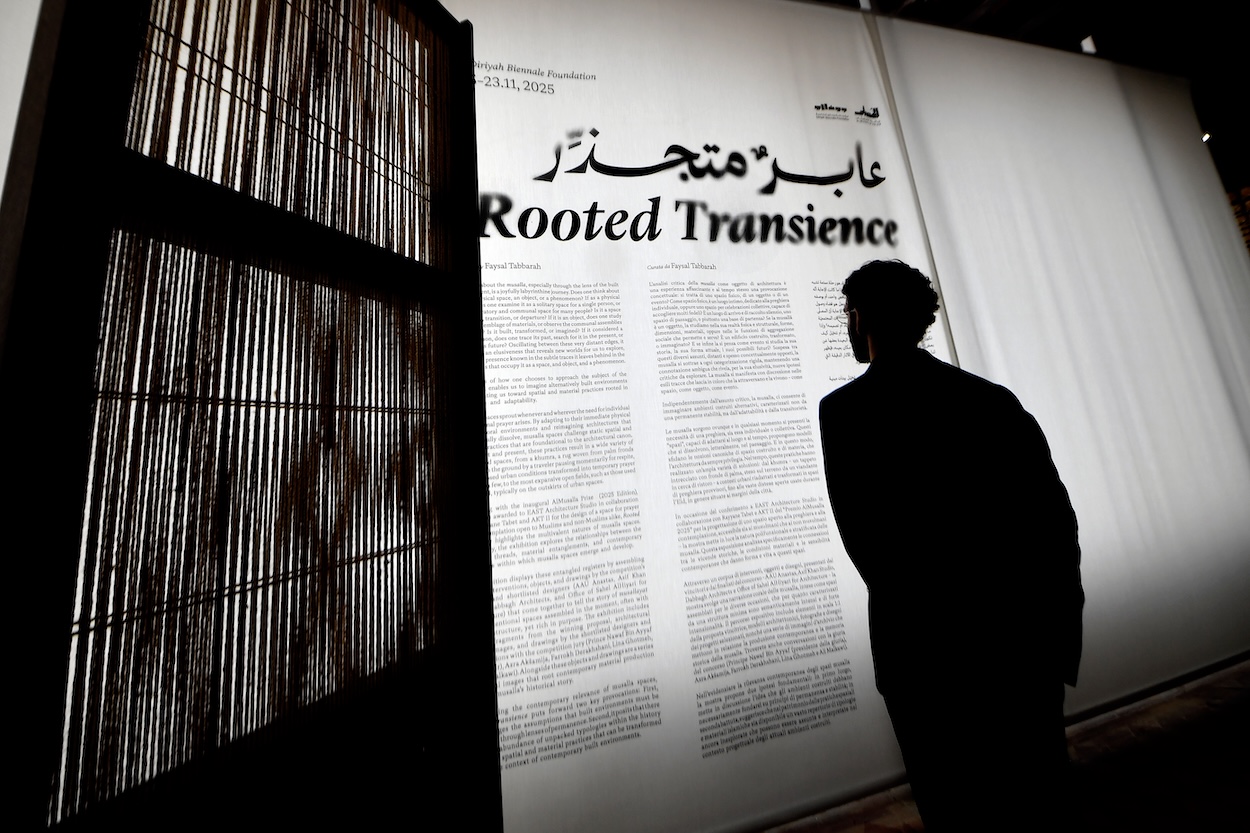
Diriyah Biennale Foundation: AlMusalla Prize 2025
Staying in the Arab peninsula—a part of the world with an ever-growing presence at the Biennale and global culture as a whole—Saudi-based Diriyah Biennale Foundation is presenting Rooted Transience. Staged at the storied Abbazia Di San Gregorio venue, the showcase presents the finalist submissions and winning proposal of the inaugural AlMusalla Prize.
Curated by Faysal Tabbarah, Associate Dean and Associate Professor of Architecture at the American University of Sharjah, the exhibition brings together speculative projects that reexamine the typology of musallas—temporary prayer spaces that can be constructed on the go. Exploring the transient and adaptable nature of this type of environment, the presentation falls directly in-line with the overall theme of this Biennale.
Designed by Lebanese firm EAST Architecture Studio—in collaboration with artist Rayyane Tabet and engineering firm AKT—the winning On Weaving project is a full scale totemic structure produced using panels of condensed date palm leaves—a natural byproduct found throughout the region. The practice drew inspiration from noted textile artist and designer Anni Albers’ theoretical approach to craft: “its inherent potential to create spaces of coexistence, where weaving becomes a multi-scalar act of making,” the exhibition text reads.
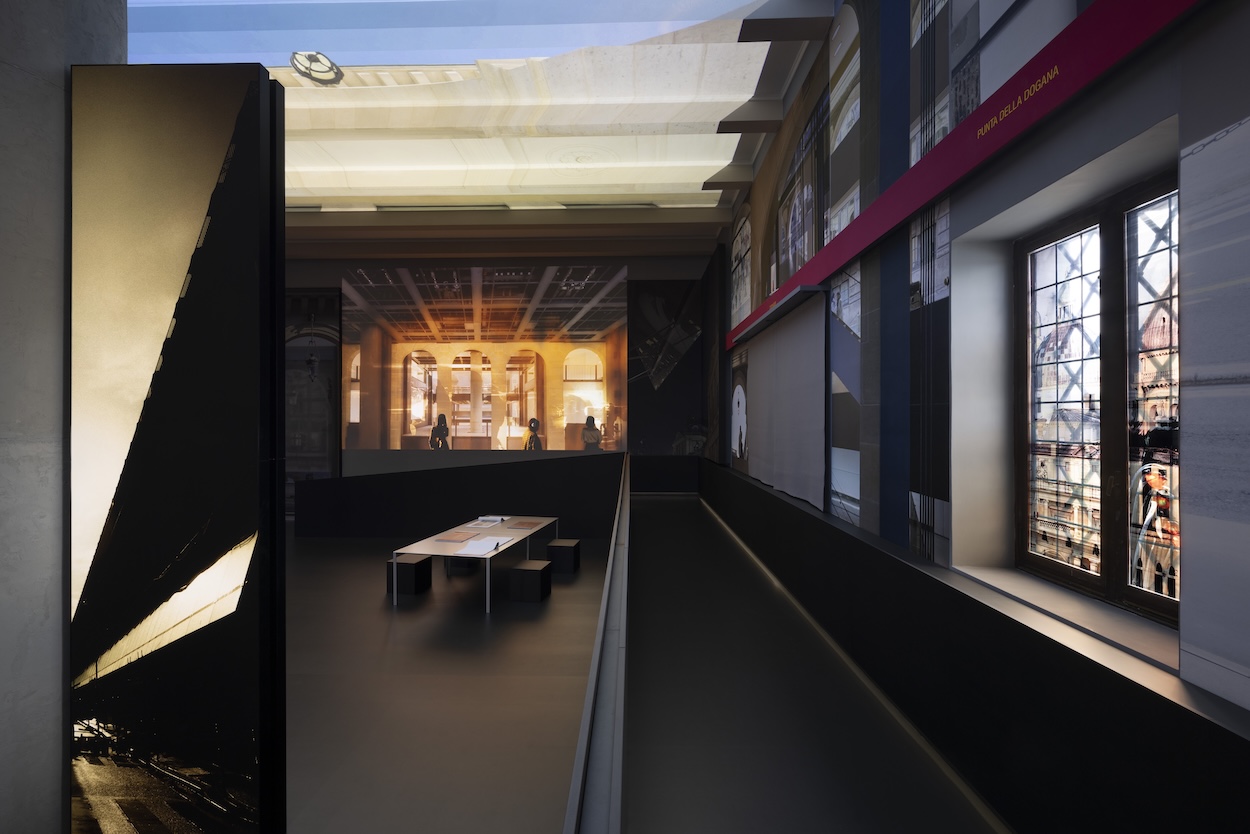
The Fondation Cartier pour l’art contemporain by Jean Nouvel
Drawing in the Biennale’s captive audience, Fondation Cartier unveiled the plans for its new central Paris location, designed by none other than Jean Nouvel. Staged at the grand Fondazione Giorgio Cini, the exhibition reveals how the noted French architect and his team are transforming the ground and subterranean levels of a mid-19th century Haussmannian building into a viable exhibition hall with flexibility in mind.
A study in adaptive reuse, the new locale—set to open later this year—will incorporate adjustable floor platforms and retractable ceilings that can accommodate different types of showcases. The exhibition-on-an-exhibition-space features interactive ‘cut-away” maquettes demonstrating these new modalities and larger site models situating the new museum within Paris’s increasingly centralized cultural district. Fondation Cartier’s latest address is right across the street from the Louvre.
